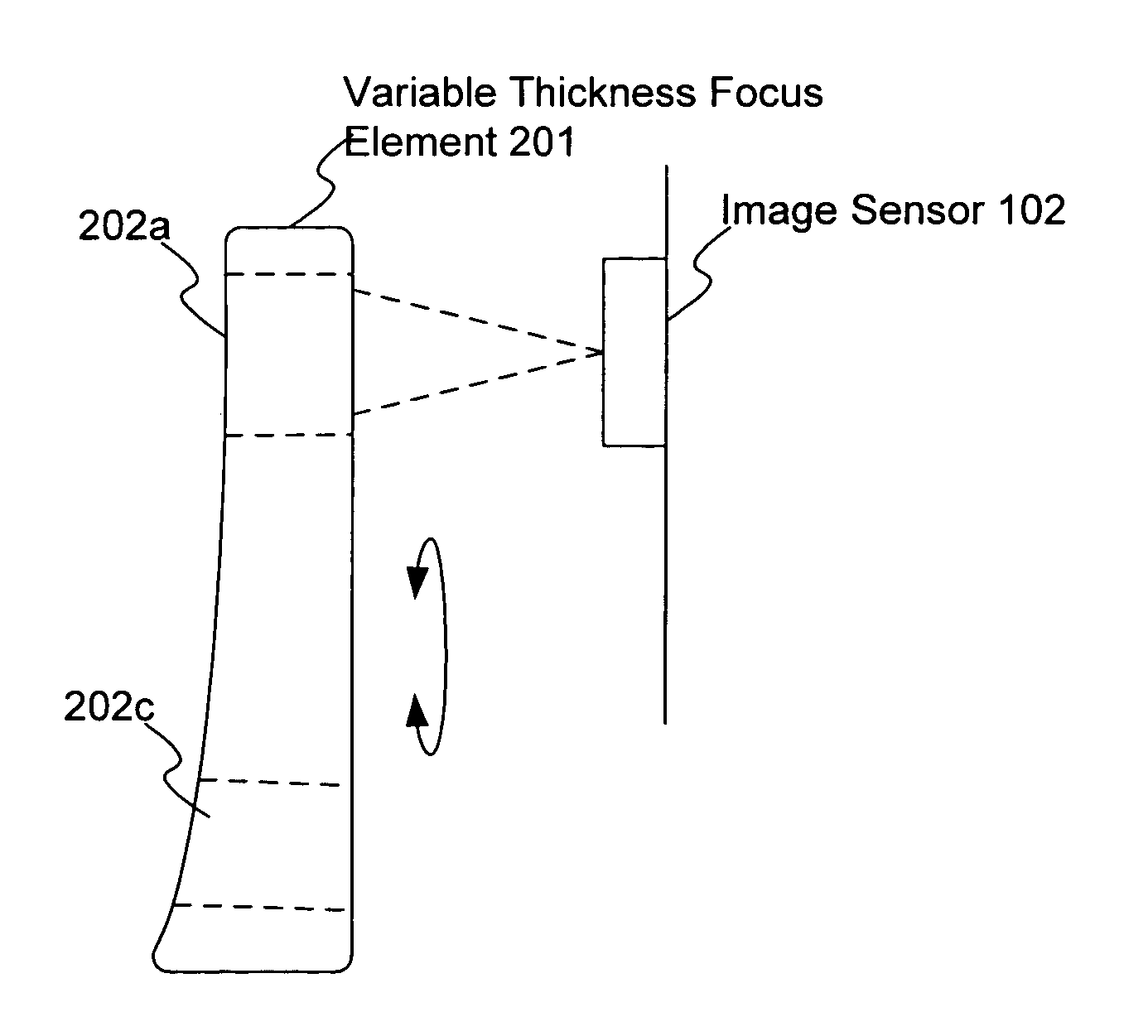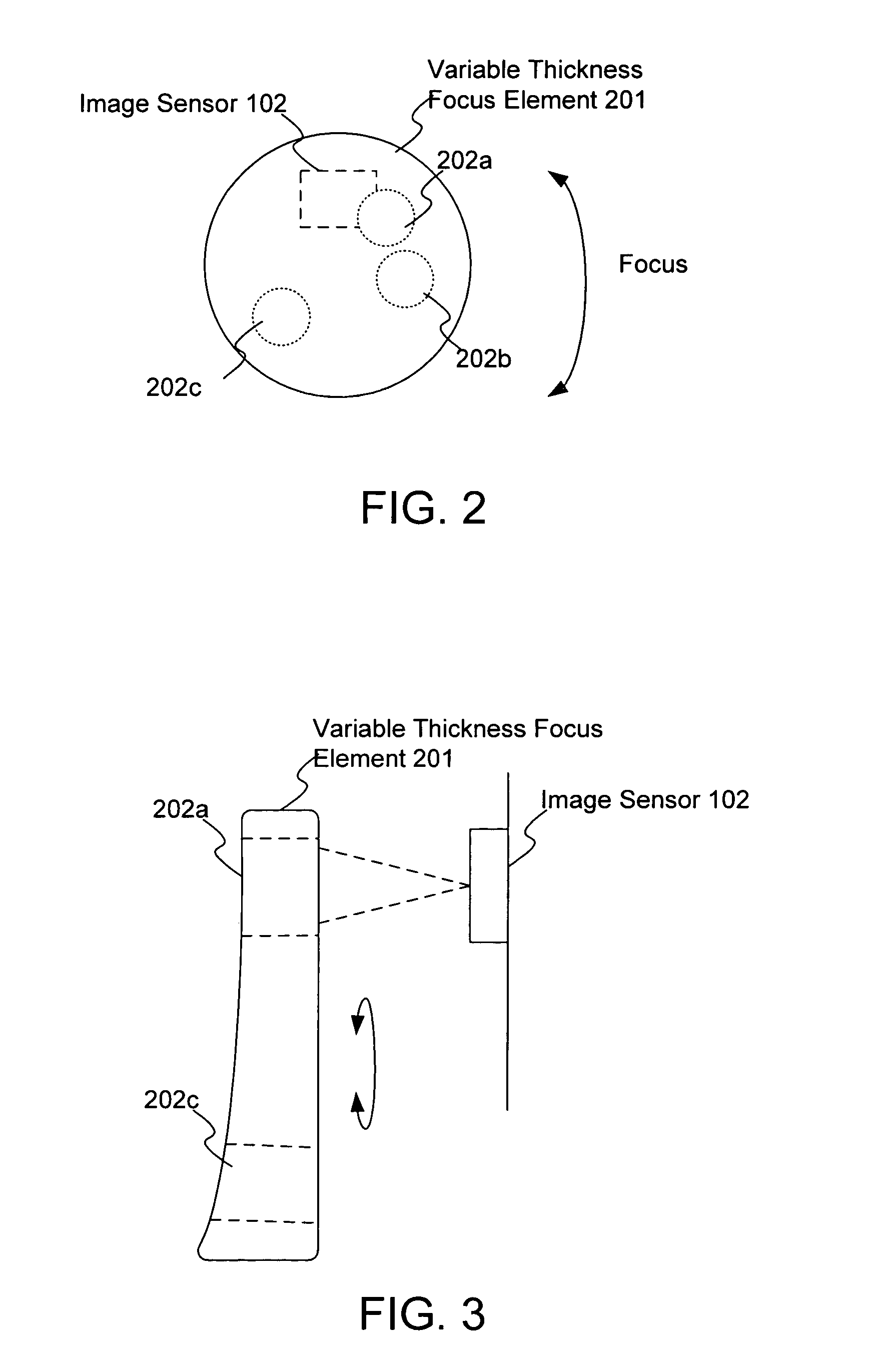Auto-focusing lens with progressive variable focal element
a technology of progressive variable focal element and auto-focusing lens, which is applied in the field of auto-focusing lenses, can solve the problems of difficult to move the lens assembly fast enough, the lens assembly becomes more complicated with more elements, etc., and achieves the effects of less inertia, less space required, and less complexity
- Summary
- Abstract
- Description
- Claims
- Application Information
AI Technical Summary
Benefits of technology
Problems solved by technology
Method used
Image
Examples
first embodiment
[0010]FIGS. 2 and 3 illustrate an image module for auto focusing in accordance with the present invention. FIG. 2 illustrates a front view, while FIG. 3 illustrates a side view. The image module includes a variable thickness focus element 201 for focusing an image onto the image sensor 102, such as portion 202a as illustrated in FIG. 3. The focus element 201 can be moved to optically couple different portions 202a–202c with the image sensor 102. Each portion 202a–202c has a different thickness, providing a different focus onto the image sensor 102. In this embodiment, the focus element 201 is rotated, such as on a spindle (not shown). Other manners of moving the focus element 201 are possible.
[0011]Unlike conventional focusing systems, the focus element 201 need not move along the optic axis in order to focus an image onto the image sensor 102. The amount of space required for the movement of the focus element 201 is significantly less. When used in a mobile device, such as a mobile...
second embodiment
[0012]FIG. 4 illustrates the image module for auto focusing in accordance with the present invention. In this embodiment, a compensation element 203 is added along the optic path between the focus element 201 and the image sensor 102. The compensation element 203 corrects for any imperfections in the focus onto the image sensor 102. For example, if the focus element 201 has a progressively variable thickness, the compensation element 203 can correct for gradients that occur between the target lengths. It can also serve as a protective window for the image sensor 102. In this embodiment, the compensation element 203 is fixed, but it can be moveable as well. It is also easier to produce than conventional lens assemblies.
third embodiment
[0013]FIG. 5 illustrates the image module for auto focusing in accordance with the present invention. In this embodiment, the focus element 201 includes a dark portion 204. When the focus element 201 is moved so that the dark portion 204 is in front of the image sensor 102, the dark portion 204 functions as a closed shutter, where no light reaches the image sensor 102. This eliminates the need for a separate shutter mechanism, further allowing the mobile device to be smaller.
[0014]An improved method and module for auto focusing has been disclosed. The method and module utilizes a variable thickness focus element. A different thickness, and thus a different focus, is optically coupled to an image sensor by rotating the focus element. Movement along the optic axis is not required. This minimizes the amount of space require to provide the auto focusing function, allowing a mobile device utilizing the module to be smaller. The dark portion of the focusing element also can provide a zero...
PUM
 Login to View More
Login to View More Abstract
Description
Claims
Application Information
 Login to View More
Login to View More - R&D
- Intellectual Property
- Life Sciences
- Materials
- Tech Scout
- Unparalleled Data Quality
- Higher Quality Content
- 60% Fewer Hallucinations
Browse by: Latest US Patents, China's latest patents, Technical Efficacy Thesaurus, Application Domain, Technology Topic, Popular Technical Reports.
© 2025 PatSnap. All rights reserved.Legal|Privacy policy|Modern Slavery Act Transparency Statement|Sitemap|About US| Contact US: help@patsnap.com



